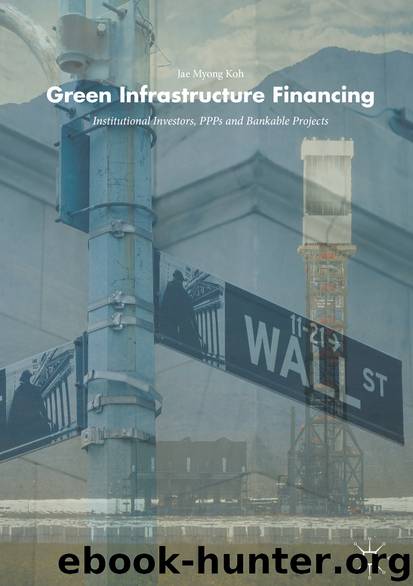Green Infrastructure Financing by Jae Myong Koh

Author:Jae Myong Koh
Language: eng
Format: epub
Publisher: Springer International Publishing, Cham
In response to such criticism by the US Senate , the developing world has an argument that is not without logic. The developing world argues that the GHGs accumulated in the atmosphere are mainly the result of industrial activities by the developed world. Accordingly, the developed world should take the historical responsibility for emitting this huge volume of GHGs thus far. Such logic of the developing world was well incorporated into the text of the UNFCCC and the Kyoto Protocol, set out as the principle of ‘common but different responsibility .’ Indeed, while the developing world argued for assumption of historical responsibility of the developed world for climate change, there was a growing concern among the developed countries about the loss of their competitiveness through placing themselves under restrictive GHG reduction targets and thus burdening their economy. Nonetheless, as regards the first commitment period of the Kyoto Protocol (2008–2012), all Annex I countries joined the campaign to reduce GHGs, apart from the USA. Then, in 2012, at the end of the first commitment period, Canada withdrew from the Kyoto Protocol. Later, Japan , New Zealand and Russia announced that they would not set new targets nor put themselves under obligations for the second commitment period (2013–2020), although they would not withdraw from the Kyoto Protocol.12 Given such controversy among the Annex I countries, it does not seem to be likely that the Doha Amendment (2012) to the Kyoto Protocol that aimed at launching the second commitment period (2013–2020) will enter into force in the near future.13 Faced with the collapse of the coalition of developed countries to fight climate change, a new approach was urgently required. As a result, the Paris mechanism emerged as an alternative to the Kyoto mechanism.
The details on the Paris mechanism are as follows: in Copenhagen in 2009, the Conference of the Parties to the UNFCCC unsuccessfully attempted to forge a treaty among industrialized and industrializing countries (EIU 2015). However, the conference did produce three pivotal political outcomes (IEA 2015)14: agreements on the global objective of holding the increase in global temperature below 2 °C; the principle that both developed and developing countries will reduce GHG15; and the establishment of the Green Climate Fund . Two years later in Durban, South Africa, the Conference of Parties to the UNFCCC agreed to prepare a new agreement with legal force by 2015 so that the new agreement could be implemented from 2020 when the Kyoto Protocol commitment period (2008–2020) comes to an end (UNFCCC 2012a). Furthermore, in Warsaw, Poland, in 2012, the Conference of Parties to the UNFCCC invited all countries to submit their voluntary targets on GHG emission reduction, called ‘intended nationally determined contributions (INDC s),’ by 2015 (UNFCCC 2014a). Indeed, the decision to urge every country to prepare its INDC was a critical step forward towards building a ‘universal and tangible’ basis for the new 2015 agreement intended to replace the Kyoto Protocol (EIU 2015).
Against such a backdrop, in Paris in 2015, the Conference of Parties to the UNFCCC adopted the Paris Agreement.
Download
This site does not store any files on its server. We only index and link to content provided by other sites. Please contact the content providers to delete copyright contents if any and email us, we'll remove relevant links or contents immediately.
| Alternative & Renewable | Drilling Procedures |
| Electric | Fossil Fuels |
| Mining | Nuclear |
| Power Systems |
Whiskies Galore by Ian Buxton(40334)
Introduction to Aircraft Design (Cambridge Aerospace Series) by John P. Fielding(32339)
Small Unmanned Fixed-wing Aircraft Design by Andrew J. Keane Andras Sobester James P. Scanlan & András Sóbester & James P. Scanlan(32141)
Craft Beer for the Homebrewer by Michael Agnew(17447)
Turbulence by E. J. Noyes(7041)
The Complete Stick Figure Physics Tutorials by Allen Sarah(6640)
Kaplan MCAT General Chemistry Review by Kaplan(6054)
The Thirst by Nesbo Jo(5786)
Bad Blood by John Carreyrou(5770)
Learning SQL by Alan Beaulieu(5412)
Weapons of Math Destruction by Cathy O'Neil(5038)
Man-made Catastrophes and Risk Information Concealment by Dmitry Chernov & Didier Sornette(4738)
iGen by Jean M. Twenge(4702)
Digital Minimalism by Cal Newport;(4545)
Life 3.0: Being Human in the Age of Artificial Intelligence by Tegmark Max(4509)
Audition by Ryu Murakami(4099)
1,001 ASVAB Practice Questions For Dummies by Powers Rod(4040)
Electronic Devices & Circuits by Jacob Millman & Christos C. Halkias(4029)
Pale Blue Dot by Carl Sagan(4003)
